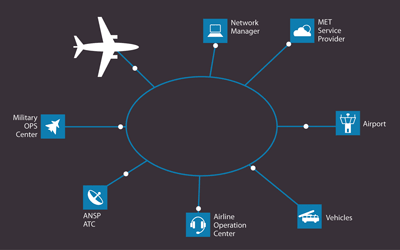SESAR SWIM keeps airports in the ATM loop
- Like
- Digg
- Del
- Tumblr
- VKontakte
- Buffer
- Love This
- Odnoklassniki
- Meneame
- Blogger
- Amazon
- Yahoo Mail
- Gmail
- AOL
- Newsvine
- HackerNews
- Evernote
- MySpace
- Mail.ru
- Viadeo
- Line
- Comments
- Yummly
- SMS
- Viber
- Telegram
- Subscribe
- Skype
- Facebook Messenger
- Kakao
- LiveJournal
- Yammer
- Edgar
- Fintel
- Mix
- Instapaper
- Copy Link
Posted: 28 July 2015 | Dirk Janssens, Walter Van Hamme, Sam Van der Stricht and Dennis Hart - EUROCONTROL
Dirk Janssens, Walter Van Hamme, Sam Van der Stricht and Dennis Hart collaboratively work together as domain experts in the field of information management, airport information and meteorology in the Information Management unit of EUROCONTROL and work on the various aspects of SWIM, contributing to SESAR. In this article they share some important European SWIM developments and highlight examples of SWIM in an airport context…


Airports are essential components in the overall Air Traffic Management (ATM) system. One of the objectives of the SES (Single European Sky) is to see airports fully integrated into the ATM network in order to increase the efficiency and overall performance of the whole European ATM system. In order to meet these objectives, the SES ATM Research Programme (SESAR) is developing a new generation ATM system in which airports play a central role. A key enabler in achieving this truly interoperable pan-European ATM system is the implementation of System Wide Information Management (SWIM).
European SESAR SWIM developments
The SESAR SWIM Concept lays down the core principles of SWIM, which consists of standards, infrastructure and governance enabling the management of ATM information and its exchange between qualified parties via interoperable services. SWIM is therefore structured around three main layers, namely information, services and infrastructure, all of which require appropriate standards to ensure interoperability. On top of these layers a transparent governance structure is foreseen to manage the development, deployment and evolution of these SWIM building blocks.
SWIM Information & Services
The ATM Information Reference Model (AIRM) provides a reference for global1 data models and as such removes all ambiguity on terminology used in the current ATM system. As part of the service orientation of the future European ATM system, the Information Service Reference Model (ISRM) serves to define European ATM Information Service descriptions. Here the general ambition is to move towards a fully integrated service oriented architecture (SOA) approach for ATM, which defines information services as the mechanism to support the ATM stakeholders in accessing, sharing, and processing ATM information. This practice of SOA is already widely used by airports and airlines for their revenue-generating customer-oriented business units and operations.
SWIM Infrastructure
The SWIM Technical Infrastructure (TI) provides the means for data to be distributed and allows for ground-ground and air-ground interoperability. The SWIM TI is pre-dominantly based on mainstream Internet Protocol (IP)-based technologies, while the underlying network connectivity is provided by secure internet connections and the Pan European Network System (PENS), the backbone network for Air Traffic Management organisations all over Europe. The SESAR programme has identified several profiles of applicable technology standards that should make the SWIM infrastructure of different organisations interoperable.
SWIM Governance
SWIM implies a harmonised and collaborative evolution in information sharing. To achieve this, a sound governance structure is needed that can ensure that SWIM rules, standards and guidance material evolve in a consistent way to support the requirements of ATM information management. Key to ensuring interoperability as well as agility is the services oriented approach (SOA). A tool supporting effective SWIM governances is the SWIM Registry, which will make available information about SWIM, such as applicable standards, guidance, service definitions, and service instances available, ensuring increased awareness among SWIM stakeholders.
With these building blocks in place, progress has been made within SESAR on a number of airport-related SWIM developments, which show just how SWIM can connect airports and ATM allowing for interoperable information sharing.
Airport Operations Plan (AOP) and Network Operations Plan (NOP) Integration
Information sharing is a foundation element of Airport Collaborative Decision Making (A-CDM), which requires the sharing of accurate and timely information between A-CDM partners in order to achieve common situational awareness and to improve traffic event predictability.
In this framework, coordinated activities between SESAR and ACI Airport Community Recommended Information Services2 (ACRIS) have resulted in the development of several A-CDM information services and a common logical definition of A-CDM information services. One such information service is ‘Airport Flight Information Publication’, which publishes inbound and outbound flight information and flight alerts. Further information services have been developed to provide or set individual values in an A-CDM context such as Target Off-Block Time (TOBT), Target Start-up Approval Time (TSAT) or Target Take-Off Time (TTOT).
For exchanging flight information, two XML-based standards have been developed called Aviation Information Data Exchange (AIDX) and Flight Information Exchange Model (FIXM). Developed by IATA and supported by ACI, AIDX is aimed at supporting airline and airport information exchanges. Meanwhile, FIXM is developed under the governance of the FIXM CCB and supervised by the ICAO Air Traffic Management Requirements and Performance Panel (ATMRPP). Both FIXM and AIDX are recognised as SWIM-based specifications for encoding the content for A-CDM information services implementations.
A-CDM also requires information exchange with the Network Manager. This is currently achieved through the exchange of Aeronautical Fixed Telecommunication Network (AFTN) messages known as Flight Update Message (FUM) & Departure Planning Information (DPI) between an airport and the Network Manager.
Analogue to the Network Operations Plan (NOP) for the ATM Network, SESAR has defined the Airport Operations Plan (AOP) at the airport level as a further evolution of A-CDM. This solution offers a single, common and collaboratively-agreed rolling plan to all airport stakeholders thereby providing common situational awareness and allowing stakeholders to make informed decisions for optimising their business operations. The SESAR concept foresees increased interconnection between the Network Operations Plan and the various Airport Operations Plans, evolving virtually to a single dynamically integrated rolling plan for air transport operations in Europe. Airport operators, ground handlers, airlines, meteorological service providers, air navigation service providers and the network manager will all contribute to this overall plan by sharing the necessary information using SWIM enabled services.
Meteo/Airports
The weather is, and will always be, a critical element in airport operations. It is not surprising therefore that weather and the need to share meteorological (MET) information figures largely in A-CDM solutions. The implementation of AOPs and the collaborative NOP will provide the common platforms for presenting this information so a move towards applying SWIM-based principles for aeronautical MET information is essential.
SWIM plays a pivotal role in creating an environment where all airport stakeholders could work from the same common understanding on the current and expected weather that will impact an airport. Today, proprietary formats or exchange infrastructures allow only a limited group of airport stakeholders to share the same weather information. Soon, through the application of SWIM, the sharing of MET information will be made easier, allowing user systems to actually consume and use the information in the form they see fit and on the device of their choice.
In this SWIM-enabled environment, information exchange standards3 are emerging that are already allowing services to be built that can share highly detailed information on e.g. thunderstorm activity directly with those working on the tarmac performing their lightning-sensitive refuelling activity, as well as the apron controllers, the cockpit and air traffic controllers. By all having access to the same information, everyone can understand better how such critical weather phenomena are affecting operations. MET information services to support de-icing operations can also be developed to enable all actors in the airport de-icing chain to appropriately understand and manage the MET context in support of their safety-critical work.
Aerodrome Mapping Database (AMDB)
Airlines are increasingly using aircraft equipped with cockpit displays that support the pilot’s situational awareness through a ‘moving map’ application when on the aerodrome movement area. The underlying standardised database is known as the Aerodrome Mapping Database (AMDB). An AMDB is a defined set of spatial and operational aerodrome data shared as a standardised data product. An AMDB includes the runways, taxiways and other features at an aerodrome.
Multiple user groups can benefit from using AMDBs. These include pilots, air traffic controllers, aerodrome managers, aerodrome emergency services, and security personnel. An AMDB can, for instance, be used in combination with notifications of runway closures to provide better situational awareness. This is a good example of delivering quality information to ‘the right people at the right time at the right place’ to support collaborative decision-making.
To exchange AMDB data based on SWIM principles, the Aerodrome Mapping Exchange Model (AMXM) is being specified (EUROCAE WG44 / RTCA SC217 Aeronautical Databases).
Furthermore, driven by stakeholder requirements, SESAR has defined the Aerodrome Mapping Information Service (AMIS). It allows a consumer to access and download aerodrome map data in a format consistent with the AMXM. This development enables the geo-temporal filtering of information and the overlay of data updates in a standardised manner by every user community with an interest in AMDB data. For example, future digital Pre-flight Pilot Information Bulletins (ePIB) could use SWIM services to fuse AMDB aerodrome mapping information with dynamic aeronautical information updates (known as digital NOTAM).
At this moment in time, the AMDB developments are driven by airside application and deployed as part of cockpit displays currently used by pilots. However, SWIM developments will inevitably spur on future services to support information sharing. Typically, when heading towards collaborative decisions and shared situational pictures it will become increasingly important to move towards SWIM as the next step in the deployment of AMDB.
Conclusion
SWIM is about delivering quality information to the right people at the right time at the right place to support collaborative decision-making. By looking at the above applications of SWIM it becomes apparent that airports are important information providers and consumers within the overall context of the European ATM Network. Furthermore, since SWIM is about working together it is a pivotal element for establishing roles and responsibilities. For airports, SWIM is an opportunity to become fully integrated into the European ATM Network and to exchange information in an interoperable way based on commonly agreed and governed principles and standards. However, it is clearly acknowledged that the evolution towards SWIM is to be done in increments that are manageable by each and every stakeholder. The examples given in this paper are proof that SWIM and SESAR are enabling airports, as information providers and users, to further their participation in a collaborative, interoperable, high performing and agile ATM system.
Plans are underway to deploy4 initial SWIM (iSWIM) across Europe by 2025. The deployment will see the provision of services such as those described in the use cases, namely for aeronautical, meteorological, and cooperative network information exchange.
References
- AIXM, (I)WXXM, FIXM and AIDX
- The ACI Airport Community Recommended Information Services (ACRIS) working group deals with the definition of Web Service standards that can support several aspects of B2B-integration between airports and their partners (e.g. airlines, ATC)
- IWXXM and WXXM
- Commission Implementing Regulation (EU) No 716/2014 of 27 June 2014 on the establishment of the Pilot Common Project supporting the implementation of the European Air Traffic Management Master Plan Text with EEA relevance
SESAR: the building blocks
2004: Establishment of SESAR (Single European Sky Air Traffic Management Research) as the technological pillar of the Single European Sky (SES).
2007: Establishment of the SESAR Joint Undertaking (SJU) as a public-private partnership to pool the knowledge and resources of the entire ATM community in order to define, research, develop and validate SESAR Solutions. The SJU has a current mandate until 2024.
2014: Establishment of the SESAR Deployment Manager (SDM) as a partnership between airlines, airports and air navigation service providers to coordinate the synchronised deployment of SESAR solutions, delivering significant benefits to airspace users and the environment.


















